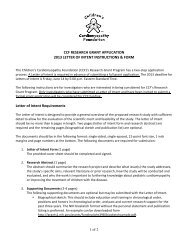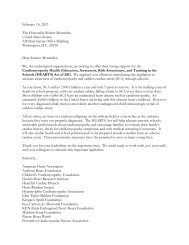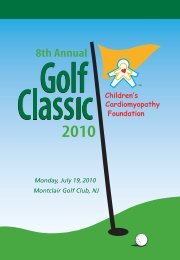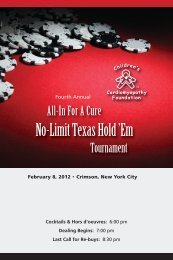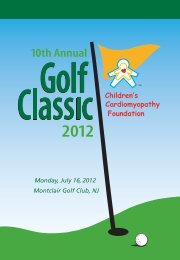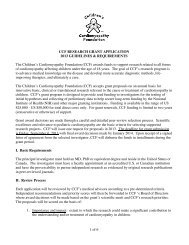68 T.L. Miller et al. / Progress <strong>in</strong> Pediatric Cardiology 24 (2007) 59–71failure generally exhibit a marked depletion (up to 50%) of bothfree and total carnit<strong>in</strong>e [89. 92]. L-Carnit<strong>in</strong>e supplementation[89,92,93] can result <strong>in</strong> overall improvement <strong>in</strong> the cardiac statusand quality of life of both animals and patients with myocardialdysfunction. A multicentered, randomized, placebo-controlled,double-bl<strong>in</strong>d cl<strong>in</strong>ical trial [94] showed a significant beneficialeffect, <strong>in</strong>clud<strong>in</strong>g a reduction <strong>in</strong> adverse cardiac remodel<strong>in</strong>g, whenL-carnit<strong>in</strong>e was taken for 12 months after myocardial <strong>in</strong>farction.Furthermore, improved 3 year survival was also found <strong>in</strong> patientsgiven daily doses of L-carnit<strong>in</strong>e [95]. Similar to other nutrients, itis clear that more studies will be needed to determ<strong>in</strong>e the potentialbenefits of this nutrient. Furthermore, there cont<strong>in</strong>ues to be adearth of studies <strong>in</strong> the <strong>pediatric</strong> population with heart failure.3.4.3. Creat<strong>in</strong>eCreat<strong>in</strong>e phosphate is the substrate for phosphate transfer toADP to form ATP by the enzymatic activity of creat<strong>in</strong>e k<strong>in</strong>ase.Creat<strong>in</strong>e is synthesized <strong>in</strong> the liver and spleen from arg<strong>in</strong><strong>in</strong>e,glyc<strong>in</strong>e and methion<strong>in</strong>e. The concentration of creat<strong>in</strong>e <strong>in</strong> themyocardiocyte is determ<strong>in</strong>ed by adrenergic drive [96], thus withheart failure, the concentration of creat<strong>in</strong>e <strong>in</strong> the cell may bedim<strong>in</strong>ished [96,97]. Creat<strong>in</strong>e can improve calcium homeostasis[98] and survival of myocytes <strong>in</strong> culture.Creat<strong>in</strong>e supplements <strong>in</strong>creases skeletal muscle creat<strong>in</strong>e, andthis may be most beneficial dur<strong>in</strong>g short-term exercise to improvemuscle strength, endurance and metabolism by reduc<strong>in</strong>g lactate[99–101]. Thus, creat<strong>in</strong>e supplementation may not be as beneficialunder normal situations. There have been few, if any studies oncreat<strong>in</strong>e's effects on heart failure, with notably none <strong>in</strong> children.3.5. Other nutrients3.5.1. Vitam<strong>in</strong> D/calciumAdequate <strong>in</strong>take (Table 1) of calcium and vitam<strong>in</strong> D needs tobe <strong>in</strong>sured, as these nutrients are critical to optimize cardiacfunction. The childhood diet is typically deficient <strong>in</strong> both ofthese nutrients with <strong>in</strong>takes of only 50% of the DRI widelyreported. In animal models, rats fed a vitam<strong>in</strong> D deficient dietdeveloped poor cardiac function that was reversed withsupplementation of vitam<strong>in</strong> D [102].3.5.2. Folate/vitam<strong>in</strong> B12Folate is required to convert homocyste<strong>in</strong>e to methione.Folate deficiency is frequently detected <strong>in</strong> patients with heartfailure [103] and often this is co<strong>in</strong>cident with low folate dietary<strong>in</strong>take [104]. Vascular endothelial function may be improved byfolate [105]. Similarly, vitam<strong>in</strong> B12 deficiency is also l<strong>in</strong>ked tohigher homocyste<strong>in</strong>e levels. However, studies show that neitherfolate nor vitam<strong>in</strong> B12 improves <strong>in</strong>tr<strong>in</strong>sic cardiac function, yetthere may be greater effects on peripheral vasculature [106].3.5.3. MagnesiumMagnesium deficiency can occur <strong>in</strong> up to 30% of patients withheart failure [107–109]. Medications, such as loop and thiazidediuretics contribute to ur<strong>in</strong>ary magnesium loss. Magnesiumdeficiency is associated with sodium retention and <strong>in</strong>creasedventricular ectopy [110–112] with associated reduced cardiaccontractility and <strong>in</strong>creased peripheral vascular resistance[113,114].3.5.4. Z<strong>in</strong>cZ<strong>in</strong>c is a trace m<strong>in</strong>eral that is required for proper function ofone of the antioxidant enzyme systems and its deficiency isrelated to apoptosis of the myocardiocyte [115]. Severalmedic<strong>in</strong>es <strong>in</strong>clud<strong>in</strong>g angiotens<strong>in</strong> convert<strong>in</strong>g enzyme <strong>in</strong>hibitors,angiotens<strong>in</strong> II antagonists and thiazide diuretics can <strong>in</strong>creaseur<strong>in</strong>ary z<strong>in</strong>c [116,117]. However, it is unclear if z<strong>in</strong>c deficiencyis related to or can improve heart failure.3.5.5. SeleniumSelenium is a trace m<strong>in</strong>eral that can be found <strong>in</strong> smallamounts <strong>in</strong> the soil and food. Depend<strong>in</strong>g on the region of theworld, foods grown <strong>in</strong> certa<strong>in</strong> areas may have sufficient or poorconcentrations of selenium ow<strong>in</strong>g to soil content. Meat andseafood have the greatest concentrations of selenium. Seleniumdeficiency has been associated with congestive <strong>cardiomyopathy</strong>(Keshan disease), skeletal myopathy, osteoarthropathy (Kash<strong>in</strong>–Beck disease), anemia, immune system alterations, <strong>in</strong>creasedrisk of cancer, cardiovascular disease, hair and nail changes,<strong>in</strong>fertility, and abnormalities <strong>in</strong> thyroid hormone metabolism <strong>in</strong>humans [118]. Selenium's greatest role is its action as a cofactorfor the antioxidant enzyme, glutathione peroxidase whichremoves hydrogen peroxide and the deleterious lipid hydroperoxidesgenerated by oxygen-derived species. Glutathioneperoxidase deficiency contributes to endothelial dysfunction amajor contribut<strong>in</strong>g factor <strong>in</strong> heart failure [119], <strong>in</strong> variousconditions such as hyperhomocyste<strong>in</strong>emia [120]. This suggeststhat homocyste<strong>in</strong>e may be <strong>in</strong>volved <strong>in</strong> heart failure associatedendothelial dysfunction through a peroxide-dependent oxidativemechanism. Selenium also plays a role <strong>in</strong> the control of thyroidhormone metabolism [121] by affect<strong>in</strong>g synthesis and activity ofde-iod<strong>in</strong>ases, enzymes convert<strong>in</strong>g thyrox<strong>in</strong> <strong>in</strong>to the biologicallyactive triiodothyron<strong>in</strong>e [122]. Thus, selenium (through its role <strong>in</strong>selenoenzymes, thyroid hormones, and <strong>in</strong>teractions with homocyste<strong>in</strong>eand endothelial function) appears to be a majormediator <strong>in</strong> several pathways potentially contribut<strong>in</strong>g to orpossibly prevent<strong>in</strong>g heart failure.The first case of endemic selenium deficiency was described<strong>in</strong> 1935 <strong>in</strong> Keshan County, <strong>in</strong> Ch<strong>in</strong>a. Cl<strong>in</strong>ical features were acuteand/or chronic episodes of cardiogenic shock and/or congestiveheart failure. Selenium supplementation may stop progression ofthe cardiac disease but is less successful at revers<strong>in</strong>g the exist<strong>in</strong>gcardiac damage [123]. The daily recommended <strong>in</strong>take ofselenium is 20–55 μg/day, depend<strong>in</strong>g on the age of the child.(30) (Table 1). Selenium deficiency <strong>in</strong> developed nations is moreoften seen <strong>in</strong> chronically ill, malnourished patients withmalabsorption and <strong>in</strong> unsupplemented total parenteral nutrition(TPN)-dependent patients [124,125]. Selenium deficiency alsois encountered when nutrient-limited diets are used such aspatients with phenylketonuria [126] and the ketogenic diet.Assessment of selenium status is difficult because no optimalmethod is known. Dietary assessment is <strong>in</strong>accurate, andselenium content depends on where the food was grown (soilcontent), which is usually unknown. Selenium can be measured
T.L. Miller et al. / Progress <strong>in</strong> Pediatric Cardiology 24 (2007) 59–7169<strong>in</strong> serum, plasma, whole blood, erythrocytes, ur<strong>in</strong>e, and hair.Serum and plasma concentrations correlate well with dietary<strong>in</strong>take and absorption and are a good <strong>in</strong>dicator of short-termselenium status. Whole-blood and erythrocyte selenium levelsreflect longer-term status. Activity of glutathione peroxidase is awell-accepted functional assay of selenium sufficiency.4. ConclusionsLittle is understood regard<strong>in</strong>g the role of growth and nutrition <strong>in</strong><strong>pediatric</strong> <strong>cardiomyopathy</strong> as a predictor of its outcomes. Understand<strong>in</strong>gthe l<strong>in</strong>k between nutrition and outcomes <strong>in</strong> <strong>pediatric</strong>cardiomyopthy would be useful <strong>in</strong> classify<strong>in</strong>g patients <strong>in</strong>to appropriateprognostic categories that will aid <strong>in</strong> the identification ofpatients who would benefit most from transplant or other types ofmedical treatment. Furthermore, understand<strong>in</strong>g the role of growthand nutrition <strong>in</strong> predict<strong>in</strong>g outcomes <strong>in</strong> <strong>pediatric</strong> <strong>cardiomyopathy</strong>may also focus attention on early and aggressive nutritional<strong>in</strong>terventions for these children that may ultimately prevent ordelay progressive decl<strong>in</strong>e <strong>in</strong> heart function or eventual hearttransplantation. There is evidence that nutrition can also be used asspecific therapy toward optimiz<strong>in</strong>g cardiac function by decreas<strong>in</strong>gthe effects of free radicals or augment<strong>in</strong>g myocardial energyproduction. However, many scientific studies are contradictory <strong>in</strong>adults with heart failure and there is a disappo<strong>in</strong>t<strong>in</strong>gly few studiesamong children with <strong>cardiomyopathy</strong>. Future efforts should focuson collaborative descriptive and <strong>in</strong>terventional studies that furtherdef<strong>in</strong>e the role of nutrition and nutritional <strong>in</strong>terventions on cardiacspecificendpo<strong>in</strong>ts as well as quality of life <strong>in</strong> children with<strong>cardiomyopathy</strong>.References[1] Nugent AW, Daubeney PE, Chondros P, et al. The epidemiology ofchildhood <strong>cardiomyopathy</strong> <strong>in</strong> Australia. N Engl J Med Apr 24 2003;348(17):1639–46.[2] Lipshultz SE, Sleeper LA, Towb<strong>in</strong> JA, et al. The <strong>in</strong>cidence of <strong>pediatric</strong><strong>cardiomyopathy</strong> <strong>in</strong> two regions of the United States. N Engl J Med Apr 242003;348(17):1647–55.[3] Grenier MA, Osganian SK, Cox GF, et al. Design and implementation ofthe North American Pediatric <strong>Cardiomyopathy</strong> Registry. Am Heart J2000;139(2 Pt 3):S86–95.[4] Boucek MM, Faro A, Novick RJ, et al. The Registry of the InternationalSociety of Heart and Lung Transplantation: Fourth Official PediatricReport-2000. J Heart Lung Transplant 2001;20:39–52.[5] Colan SD, Spevak PJ, Parness IA, et al. Cardiomyopathies. In: Fyler DC,editor. Nadas' Pediatric Cardiology. New York: Balfus and Hanley; 1992.[6] Burch M, Siddiqi SA, Celermajer DD, et al. Dilated <strong>cardiomyopathy</strong> <strong>in</strong>children: determ<strong>in</strong>ants of outcome. Br Heart J 1994;72:246–50.[7] Maron BJ, Tajik AJ, Ruttenberg HD, et al. Hypertrophic <strong>cardiomyopathy</strong><strong>in</strong> <strong>in</strong>fants: cl<strong>in</strong>ical features and natural history. Circulation1982;65(1):7–17.[8] Towb<strong>in</strong> JA, Bowles NE. The fail<strong>in</strong>g heart. Nature Jan 10 2002;415(6868):227–33.[9] Thiene G, Becker AE, Buja LM, et al. Toward a cardiovascular pathologytra<strong>in</strong><strong>in</strong>g report on the forum held <strong>in</strong> Vancouver, March 6, 2004, Societyfor Cardiovascular Pathology. Cardiovasc Pathol Nov Dec 2005;14(6):312–9.[10] Boucek MM, Edwards LB, Keck BM, et al. The Registry of the InternationalSociety for Heart and Lung Transplantation: Sixth Official Pediatric Report-2003. J Heart Lung Transplant 2003;22:636–52.[11] Bilgic A, Ozbarlas N, Ozkutlu S, et al. Cardiomyopathies <strong>in</strong> children:cl<strong>in</strong>ical, epidemiological and prognostic evaluation. Jpn Heart J1990;31:789–97.[12] Lipshultz SE. Ventricular dysfunction cl<strong>in</strong>ical research <strong>in</strong> <strong>in</strong>fants,children and adolescents. Prog Pediatr Cardiol Nov 4 2000;12(1):1–28.[13] Evans RW. Economic and social costs of heart transplantation. HeartTransplant 1982;1:243–51.[14] Strauss A, Lock JE. Pediatric <strong>cardiomyopathy</strong>—a long way to go. N EnglJ Med Apr 24 2003;348(17):1703–5.[15] Blecker U, Mehta DI, Davis R, et al. <strong>Nutrition</strong>al problems <strong>in</strong> patients whohave chronic disease. Pediatr Rev 2000;21(1):29–32.[16] Karp RJ, Bachrach SJ, Moskowitz S. Malnutrition <strong>in</strong> chronic illness ofchildhood with special reference to pulmonary disease. Cl<strong>in</strong> Chest Med1980;1(3):375–83.[17] Kelly DA. <strong>Nutrition</strong> and growth <strong>in</strong> patients with chronic liver disease.Indian J Pediatr 1995;62(5):533–44.[18] Kohaut EC. Chronic renal disease and growth <strong>in</strong> childhood. Curr Op<strong>in</strong>Pediatr 1995;7(2):171–5.[19] Yip R, Scanlon K. The burden of malnutrition: a population perspective.J Nutr 2002;10:2043s–6s [supplement].[20] Franssen FM, Wouters EF, Schols AM. The contribution of starvationdecondition<strong>in</strong>g and age<strong>in</strong>g to the observed alterations <strong>in</strong> peripheralskeletal muscle <strong>in</strong> chronic organ diseases. Cl<strong>in</strong> Nutr 2002;21(1):1–14.[21] Keusch GT. The history of nutrition: malnutrition, <strong>in</strong>fection, and immunity.J Nutr 2003;133(1):336s–40s.[22] Hughes WT, Price RA, Sisko F, et al. Prote<strong>in</strong>–calorie malnutrition. A hostdeterm<strong>in</strong>ant for Pneumocystis carnii. Am J Dis Child 1974;128(1):44–52.[23] Miller TL, Awnetwant EL, Evans S, et al. Gastrostomy tube supplementationfo HIV-<strong>in</strong>fected children. Pediatrics 1995;96:696–702.[24] Al-Attar I, Orav EJ, Exil V, et al. Pedictors of cardiac morbidity andrelated mortality <strong>in</strong> children with acquired immunodeficiency syndrome.J Am Coll Cardiol 2003;41(9):1598–605.[25] Azevedo VM, Albanesi-Filho FM, Santos MA, et al. The impact ofmalnutrition on idiopathic dilated <strong>cardiomyopathy</strong> <strong>in</strong> children. J Pediatr(Rio J) 2004;80(3):211–6 [Portuguese].[26] Leitch CA. Growth, nutrition and energy expenditure <strong>in</strong> <strong>pediatric</strong> heartfailure. Prog Pediatr Cardiol 2000;11(3):195–202.[27] Miller TL, Orav EJ, Colan SD, Lipshultz SE. <strong>Nutrition</strong>al status and cardiacmass and function <strong>in</strong> children <strong>in</strong>fected with the human immunodeficiencyvirus. Am J Cl<strong>in</strong> Nutr Sep 1997;66(3):660–4.[28] Davos CH, Doehner W, Rauchhaus M, et al. Body mass and survival <strong>in</strong>patients with chronic heart failure without cachexia: the importance ofobesity. J Card Fail Feb 2003;9(1):29–35.[29] Horwich TB, Fonarow GC, Hamilton MA, MacLellan WR, Woo MA,Tillisch JH. The relationship between obesity and mortality <strong>in</strong> patientswith heart failure. J Am Coll Cardiol Sep 2001;38(3):789–95.[30] Dietary Reference Intakes for Calcium, Phosphorus, Magnesium,Vitam<strong>in</strong> D, Fluoride (1997). Dietary Reference Intakes for Thiam<strong>in</strong>,Riboflav<strong>in</strong>, Niac<strong>in</strong>, Vitam<strong>in</strong> B6, Folate, Vitam<strong>in</strong> B12 (1998). DietaryReference Intakes for vitam<strong>in</strong> C, Vitam<strong>in</strong> E, Selenium, and Carotenoids(2000).Dietary Reference Intakes for Vitam<strong>in</strong> A, Vitam<strong>in</strong> K, Arsenic,Boron, Chromium, Copper, Iod<strong>in</strong>e, Iron, Manganese, Molybdenum,Nickel, Silicon, Vanadium, and Z<strong>in</strong>c (2001). Dietary Reference Intakesfor Energy, Carbohydrate, Fiber, Fat, Fatty Acids, Cholesterol, Prote<strong>in</strong>,and Am<strong>in</strong>o Acids (2002). Dietary Reference Intakes for Water,Potassium, Sodium, Chloride, and Sulfate (2004). Food and <strong>Nutrition</strong>Board, Institute of Medic<strong>in</strong>e, National Academies of Sciences. RetrievedJune 20, 2007 from http://www.nap.edu.[31] L<strong>in</strong>de LM. Psychiatric aspects of congenital heart disease. Psychiatr Cl<strong>in</strong>North Am 1982;5:399–406.[32] Howard BV, Van Horn L, Hsia J, et al. Low-fat dietary pattern and riskof cardiovascular disease: the Women's Health Initiative RandomizedControlled Dietary Moification Trial. JAMA Feb 8 2006;295(6):655–66.[33] Sparagna GC, Hickson-Bick DL, Buja LM, McMill<strong>in</strong> JB. A metabolicrole for mitochondria <strong>in</strong> palmitate-<strong>in</strong>duced cardiac myocyte apoptosis.Am J Physiol Heart Circ Physiol Nov 2000;279(5):H2124–32.




